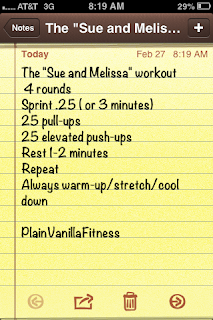February Fitness Challenge
Alrighty, with all the January resolutions fizzled, I'd like to present February, which I like to call the "do-over" month. February is also heart healthy month. For the next few weeks or so, let's push ourselves to make our heart healthy (myself included, so I need all of you for motivation!). You will weigh-in weekly, have a COW (challenge of the week), and other tips to help you on your journey.
Here is the printable calendar for your fridge:
(right click, and open image in a new window)
If you aren’t sure what type of exercises you need to do each day or what intensity your workout should be below is an explanation on how to build an exercise program. First off though, see your physician before beginning any kind of exercise routine. Don't go out there and try to be a super star, work out for two hours, then you can't move the next day. Example: walk for 10 minutes the first week, and add on a few minutes the following week. Read over the FITT, and see how you can incorporate each section daily.
I also wanted to talk about heart rate. A lot of people ask me "What should my heart be when I am exercising?" It is based on your fitness level, and of course your age. Click on the link below, enter your age, and it will provide you with a beginner, intermediate, or advanced heart rate.
https://www.acefitness.org/acefit/healthy_living_tools_content.aspx?id=7
How To: Build An Exercise Program
An awesome general guideline to use when building your exercise program is:
FITT- Frequency, Intensity, Time, and Type.
Frequency: How frequently the exercise or activity is performed in terms of times per day and/or days per week
This is the number of exercise sessions per week for a healthy adult.
- Cardiovascular Exercise: 3-5x/week
- Resistance Training: 2-3x/week
- Flexibility Work: 2-7x/week
**Highly deconditioned adults: most days of the week.
Intensity: The level of exercise in terms of heart rate, perceived exertion, pounds, strength levels, METS, etc.
This is the measure of your perceived workload during the exercise.
- Cardiovascular Exercise: measured through VO2 %, RPE (rate of perceived exertion on a scale of 7-20), or heart rate %
- Resistance Training: work to fatigue, or 19-20 RPE
- Flexibility Work: stretch as far as you can at a full range of motion without pain
**Highly deconditioned adults: Perceived exertion "moderate", at least 55%-64% maximum heart rate.
Time: The duration of the exercise or activity in minutes and/or sets
This is simply how much time you spend on the exercise.
- Cardiovascular Exercise: 20-60 minutes/session
- Resistance Training: 2-3 sets of 6-15 reps/exercise
- Flexibility Work: 15-30 seconds/stretch
**Highly deconditioned adults: 10-30 minutes, this can be done in 10-minute bouts accumulated throughout the day.
Type: The mode or description of the exercise or activity.
Type is the kind of activity you are doing.
- Cardiovascular Exercise: dynamic activity using the major muscle groups
- Resistance Training: include all the major muscle groups
- Flexibility Work: include all the major muscle groups
** Highly deconditioned adults: Continuous movement or activity including gardening, housework, and other activities of daily living.
A FITT example for a sedentary person from ACE Fitness:
F: 3 sessions/week
I: 50-60% heart rate reserve or 12-13 RPE
T: 20-30 minutes/session
T: Walking, cycling, or swimming
Let the challenge begin!!! :D
Source: Sports Fitness Advisor: The FITT Principle of Training, ACE:Are you FITT to be a Personal trainer










